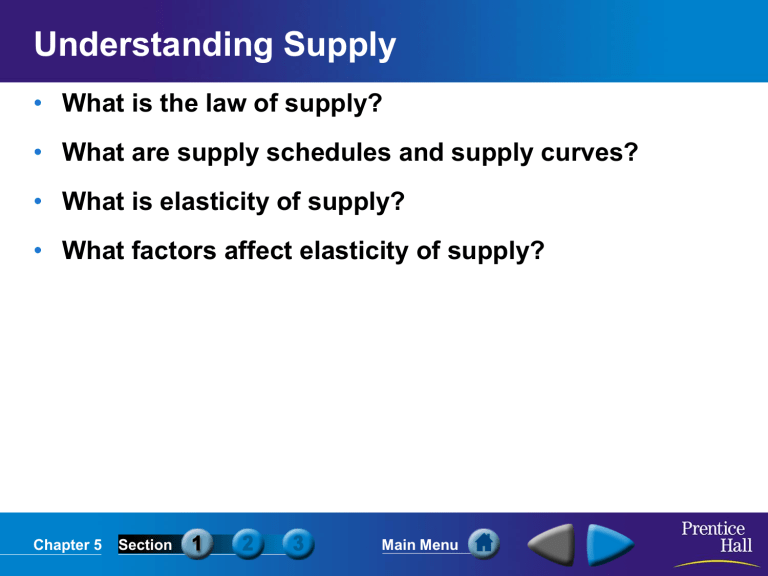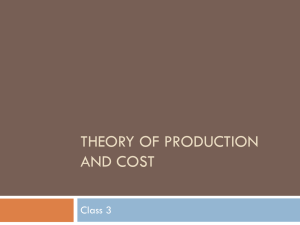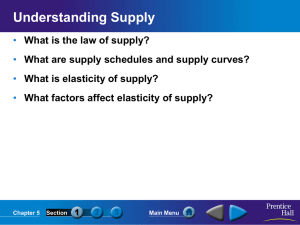Supply

Understanding Supply
• What is the law of supply?
• What are supply schedules and supply curves?
• What is elasticity of supply?
• What factors affect elasticity of supply?
Chapter 5 Section Main Menu
The Law of Supply
• According to the law of supply, suppliers will offer more of a good at a higher price.
Price
As price increases…
Supply
Quantity supplied increases
Price
As price falls…
Supply
Quantity supplied falls
Chapter 5 Section Main Menu
How Does the Law of Supply Work?
• Economists use the term quantity supplied to describe how much of a good is offered for sale at a specific price.
• The promise of increased revenues when prices are high encourages firms to produce more.
• Rising prices draw new firms into a market and add to the quantity supplied of a good.
Chapter 5 Section Main Menu
Supply Schedules
• A market supply schedule is a chart that lists how much of a good all suppliers will offer at different prices.
Market Supply Schedule
Price per slice of pizza Slices supplied per day
$.50
$1.00
$1.50
$2.00
$2.50
$3.00
1,000
1,500
2,000
2,500
3,000
3,500
Chapter 5 Section Main Menu
Supply Curves
• A market supply curve is a graph of the quantity supplied of a good by all suppliers at different prices.
Market Supply Curve
1.00
.50
0
3.00
2.50
2.00
1.50
Supply
0 500 1000 1500 2000 2500 3000 3500
Output (slices per day)
Chapter 5 Section Main Menu
Elasticity of Supply
Elasticity of supply is a measure of the way quantity supplied reacts to a change in price.
• If supply is not very responsive to changes in price, it is considered inelastic.
• An elastic supply is very sensitive to changes in price.
Chapter 5 Section Main Menu
What Affects Elasticity of Supply?
• In the short run, a firm cannot easily change its output level, so supply is inelastic.
Time
• In the long run, firms are more flexible, so supply can become more elastic.
Chapter 5 Section Main Menu
Costs of Production
• How do firms decide how much labor to hire?
• What are production costs?
• How do firms decide how much to produce?
Chapter 5 Section Main Menu
A Firm’s Labor Decisions
• Business owners have to consider how the number of workers they hire will affect their total production.
• The marginal product of labor is the change in output from hiring one additional unit of labor, or worker.
Marginal Product of Labor
Labor
(number of workers)
2
3
0
1
4
7
8
5
6
Output
(beanbags per hour)
0
4
10
17
23
28
31
32
31
Marginal product of labor
—
4
6
7
6
1
–1
5
3
Chapter 5 Section Main Menu
Marginal Returns
Increasing marginal returns occur when marginal production levels increase with new investment.
Diminishing marginal returns occur when marginal production levels decrease with new investment.
Negative marginal returns occur when the marginal product of labor becomes negative.
Increasing, Diminishing, and
Negative Marginal Returns
0
–1
–2
–3
2
1
4
3
6
5
8
7
Increasing marginal returns
Diminishing marginal returns
Negative marginal returns
1 2 3 4 5 6 7 8 9
Labor
(number of workers)
Chapter 5 Section Main Menu
Production Costs
• A fixed cost is a cost that does not change, regardless of how much of a good is produced. Examples: rent and salaries
• Variable costs are costs that rise or fall depending on how much is produced. Examples: costs of raw materials, some labor costs.
• The total cost equals fixed costs plus variable costs.
• The marginal cost is the cost of producing one more unit of a good.
Chapter 5 Section Main Menu
Setting Output
• Marginal revenue is the additional income from selling one more unit of a good. It is usually equal to price.
• To determine the best level of output, firms determine the output level at which marginal revenue is equal to marginal cost.
Production Costs
Beanbags
(per hour)
6
7
8
2
3
4
5
0
1
9
10
11
12
Fixed cost
$36
36
36
36
36
36
36
36
36
36
36
36
36
Variable cost
82
106
136
173
$0
8
12
15
20
27
36
48
63
Total cost
(fixed cost + variable cost)
$36
44
48
51
56
63
72
84
99
118
142
172
209
Marginal cost
—
$8
4
3
5
7
9
12
15
19
24
30
37
Marginal revenue
(market price)
$24
24
24
24
24
24
24
24
24
24
24
24
24
$0
24
48
72
96
120
144
168
192
216
240
264
288
Total revenue
Profit
(total revenue – total cost)
$
–36
–20
0
21
40
57
72
84
93
98
98
92
79
Chapter 5 Section Main Menu
Changes in Supply
• How do input costs affect supply?
• How can the government affect the supply of a good?
• What other factors can influence supply?
Chapter 5 Section Main Menu
Input Costs and Supply
• Any change in the cost of an input such as the raw materials, machinery, or labor used to produce a good, will affect supply.
• As input costs increase, the firm’s marginal costs also increase, decreasing profitability and supply.
• Input costs can also decrease. New technology can greatly decrease costs and increase supply.
Chapter 5 Section Main Menu
Government Influences on Supply
• By raising or lowering the cost of producing goods, the government can encourage or discourage an entrepreneur or industry.
Subsidies
A subsidy is a government payment that supports a business or market. Subsidies cause the supply of a good to increase.
Taxes
The government can reduce the supply of some goods by placing an excise tax on them. An excise tax is a tax on the production or sale of a good.
Regulation
Regulation occurs when the government steps into a market to affect the price, quantity, or quality of a good. Regulation usually raises costs.
Chapter 5 Section Main Menu
Other Factors Influencing Supply
• The Global Economy
– The supply of imported goods and services has an impact on the supply of the same goods and services here.
– Government import restrictions will cause a decrease in the supply of restricted goods.
• Future Expectations of Prices
– Expectations of higher prices will reduce supply now and increase supply later. Expectations of lower prices will have the opposite effect.
• Number of Suppliers
– If more firms enter a market, the market supply of the good will rise. If firms leave the market, supply will decrease.
Chapter 5 Section Main Menu







